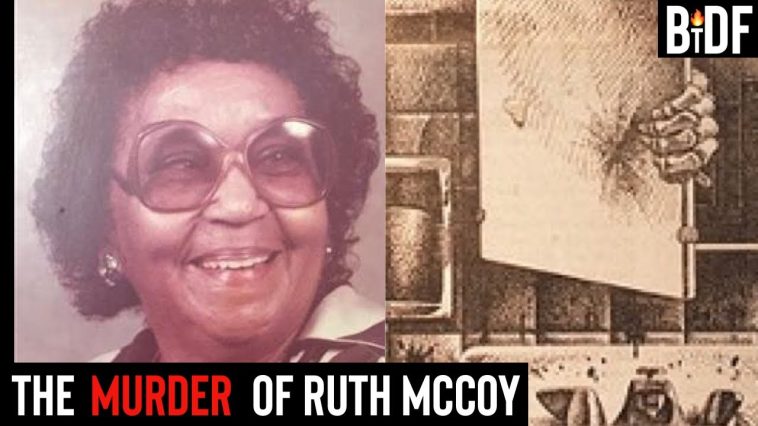Ruthie Mae McCoy was a resident of the Abbott Homes housing projects in Chicago, Illinois in the late 1980s. Her chilling murder in 1987 brought attention to issues of public housing conditions, mental health support, and crime. McCoy’s case also served as inspiration for the iconic horror movie Candyman. Though her life was filled with hardship, McCoy’s story continues to reverberate today as an urgent call for social reform.
Early Life
Ruthie Mae McCoy was born in 1935 in Arkansas. Her family later moved to the South Side of Chicago, hoping for more opportunities. However, McCoy’s childhood was marked by financial struggles and instability at home. Poverty cast a heavy shadow over her early years, making survival a daily battle.
Mental Illness
As an adult, Ruthie Mae McCoy suffered from mental illness, including symptoms of paranoia and delusions. At the time, there were few community resources or support systems available to help those dealing with mental health issues, especially in low-income neighborhoods.
McCoy likely did not have access to consistent clinical treatment. The stigmas surrounding mental illness also deterred individuals from seeking assistance that could have improved their conditions. Tragically, this lack of care contributed to McCoy’s declining state in her final years.

Life in Chicago Public Housing
To obtain affordable housing, Ruthie Mae McCoy lived in Chicago’s infamous Cabrini–Green Homes public housing projects for over 20 years. The dilapidated high-rises were notorious for poverty, violence, and neglected living conditions – issues endemic to many of the city’s public housing developments.
In the 1980s, McCoy relocated to the Abbott Homes, another CHA project plagued by similar problems. Gang activity and crime were rampant within the complex. Building maintenance and safety concerns often went unaddressed by management.
The Murder of Ruthie Mae McCoy
On April 22, 1987, a horrific crime took place inside the Abbott Homes. Police received calls about gunfire in Ruthie Mae McCoy’s apartment. Upon entering, they discovered a grisly scene – McCoy shot to death in her bedroom, the space ransacked.
Detectives determined that the perpetrators broke in through the bathroom mirror to ambush McCoy by surprise. Tragically, her body was left undiscovered for several days after the initial attack.
The chilling murder stunned residents and quickly made local headlines. Reporters seized upon the more sensational details: a woman killed in her own home by intruders exploiting building lapses and allegedly using the incident to inspire the horror film Candyman.
The Investigation
Police investigated a group of young men potentially involved with the break-in and McCoy’s murder. However, the case soon went cold with no convictions – a grave injustice to McCoy and a deep blow to the community.
The botched investigation exemplified the apathy and lack of accountability towards violence against public housing residents at the time. Many felt McCoy’s life was viewed as less valuable due to socioeconomic status, race, and mental health – leading to fewer resources dedicated to solving her case.

Justice? Not for Ruthie Mae McCoy
Ultimately, no arrests were made in connection to Ruthie Mae McCoy’s death. The failure to find and prosecute those responsible remains an open wound, leaving her family and neighborhood without real closure.
McCoy’s unresolved murder case reflected the rampant crime in Chicago public housing projects – much of it unsolved and unaccounted for as violence disproportionately impacted marginalized communities.
A Legacy of Indifference
Behind the chilling details, Ruthie Mae McCoy’s story is one of a system that failed to protect or support her.
McCoy failed because of the substandard living conditions and lack of security in Chicago public housing. She was also failed by the mental health stigma and lack of investment in social services. And she was failed again by law enforcement’s apathetic response after her murder.
McCoy’s case is a painful reminder of the human costs of institutional indifference and the changes still needed to prevent similar tragedies today.

Impact on Chicago Housing Authority (CHA)
In the wake of Ruthie Mae McCoy’s unsolved murder, the Chicago Housing Authority faced intense scrutiny. McCoy’s death represented the worst fears of public housing residents – violence, victimization, and neglect coming from within the properties themselves.
Abbott Homes in particular became notorious. The CHA eventually earmarked the complex for demolition to revitalize mixed-income housing. However, the failed promises of redevelopment would also stir controversy in later years.
More broadly, McCoy’s case directed overdue attention towards improving safety and quality of life for CHA tenants. Her senseless death put human faces to the urgent need for reform. Incremental policy changes followed though systemic issues persisted even after high-rise projects gave way to new mixed-income developments. The legacy remains complex and unfinished.
The Story Immortalized | Candyman
Though she only lived to age 51, Ruthie Mae McCoy’s name will perhaps always be intertwined with Candyman. The 1992 cult horror film took inspiration from McCoy’s murder in the Abbott Homes, incorporating chillingly similar details into its central plot.
Candyman centered around the ghost of an artist murdered in the Cabrini-Green housing projects, mirroring the real-world backdrop of urban decay and violence. In the film, the main female protagonist is also terrorized in her bathroom before meeting a grisly end. Ruthie Mae McCoy’s essence permeates various elements of Candyman, immortalizing her in pop culture infamy.
Final Thoughts
Ruthie Mae McCoy’s truncated life and violent murder provide sobering lessons we cannot afford to ignore today. Too often, cases of inner-city violence are dismissed as inevitable – but McCoy’s story powerfully confronts us with the human costs of a broken system. We must ask ourselves if enough has changed to prevent similar tragedies moving forward.
McCoy’s experience also underscores the need for greater investment in mental health resources and ending stigmas that deter people from seeking life-saving care. We fail communities when social services are gutted or made inaccessible.
Though McCoy did not receive justice in her own life, her memory carries the power to inspire it for others. We owe it to her legacy to push for reforms across public housing, healthcare, and law enforcement – working towards a more just and compassionate society for all.





